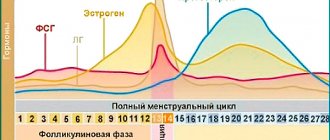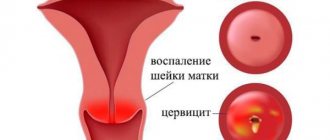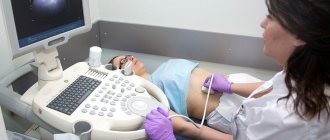How does a cyst come out during menstruation?
First you need to understand the mechanism of formation of functional tumors. Under the influence of hormones, one of the follicles increases in size. He develops quickly and dominates the others. Under the influence of luteinizing hormone, the follicle ruptures, an egg is released, which subsequently enters the abdominal cavity and attaches to the uterus.
In place of the dominant vesicle, a corpus luteum is formed; its main task is to form the placenta in the event of fertilization. In cases where conception has not occurred, the corpus luteum undergoes regression.
If for some reason the follicle does not rupture, a follicular cyst forms. It is a single-chamber tumor, which consists of a thin-walled membrane and fluid containing estrogens. This is the mildest pathology, which often occurs without pronounced symptoms and disappears on its own. A large ovarian cyst during menstruation manifests itself as pain in the side of its location. The pain radiates to the sacrum and spreads to the lower abdomen. Menstruation with a functional neoplasm can be longer and more abundant than usual.
It happens that the corpus luteum does not resolve, then a luteal cyst is formed, filled with yellow liquid. The formation can rupture with hemorrhage inside the cavity. Often the luteal tumor disappears spontaneously, but a doctor’s supervision is required for 2 months.
Can an ovarian cyst come out with menstruation? This is true for functional tumors. The tumor can resolve under the influence of medications prescribed by a doctor. The timely onset of menstruation indicates the patient’s recovery. Menstruation at this moment is lighter than usual. There is increased pain and the appearance of blood clots.
It is worth disappointing women who are trying to see how the cyst comes out. Even a careful examination of the contents of the pad will not help to understand whether the tumor has resolved or not. Only a repeat appointment with the gynecologist and a control ultrasound will help clarify the situation.
Dangerous complications of neoplasms during a woman’s menstruation and their delay
Sometimes an ovarian cyst swells and increases in size during menstruation and can burst when pressure is placed on it or excessive stress on the abdominal muscles.
This is typical for dermoid, endometrioid, and muciotic formations. Their contents spill into the abdominal cavity, causing peritonitis. Such an acute condition requires emergency care and urgent hospitalization in a surgical hospital. In addition, ignoring symptoms and illiterate self-medication can lead to malignancy of cysts. Therefore, any bloody discharge from the vagina is a reason to immediately go to the clinic. Blood outside the normal menstrual cycle should alert a woman; its unexpected appearance in the discharge is a sign of serious diseases of the genital area.
Cystic ovarian formations pose a serious danger to women's health, so it is important to consult a doctor promptly if there are any signs of illness (disturbance in the menstrual cycle, their delay, pain in the lower abdomen, bleeding).
Timely examination helps to identify benign tumors, determine the nature and stage of the disease and begin treatment. Correctly selected conservative therapy often leads to the resorption of ovarian cysts, which reduces the likelihood of delayed menstruation and helps restore the normal functioning of the ovaries, and planned surgical removal of tumors prevents the development of their malignant degeneration.
Can an ovarian cyst resolve on its own?
Functional cysts (luteal and follicular) are capable of independent regression. The walls of the tumor collapse, the cavity fluid gradually resolves. Small tumors go away without any treatment; in other cases, the doctor prescribes combined oral contraceptives. The drugs neutralize the function of follicle-stimulating hormone and temporarily stop the maturation of the egg. The ovary has time to restore its structure. Hormonal agents are also used to prevent new cystic degenerations.
A woman will not be able to feel how an ovarian cyst dissolves during menstruation. This process usually occurs asymptomatically, without specific signs. At other times, small discharge appears, and the woman feels slight nagging pain in the area of the affected ovary.
Other tumors of the gonads - dermoid, endometrioid cysts - cannot disappear spontaneously without treatment. A dermoid cyst, formed from embryonic cells, has a thick-walled capsule and various inclusions (hair, skin, fat cells). It is not a hormone-dependent tumor and can only be eliminated surgically.
Endometriotic ovarian cysts consist of leaked menstrual blood and endometrial cells. Before menstruation, the cyst reacts to hormonal changes and begins to bleed. Its cavity increases with each cycle. Such formation does not disappear on its own. Long-term treatment with hormones and surgical removal are required.
Can menstruation be delayed after laparoscopy of an ovarian cyst?
Complicated ovarian cysts (progressive or bleeding) are removed surgically using abdominal or laparoscopic surgery.
As a rule, the postoperative period goes well. Women recover quickly and are discharged from the hospital a few days after laparotomy. The appearance of menstruation during the rehabilitation process in patients under 30 years of age usually occurs in the second or third week. In older women, after a longer period (3-4 weeks).
Can an ovarian cyst burst during menstruation?
Rupture of the membrane can occur at any time, not just during menstruation. Provoking factors are:
- Intense physical activity;
- Sexual contact;
- Constipation and overeating (intra-abdominal pressure increases);
- Increased intestinal peristalsis;
- Sexual infections and inflammation of the reproductive organs.
A woman with an ovarian cyst should avoid sudden movements, heavy lifting, jumping, aerobics and horseback riding. Any awkward movement can lead to tearing of the tumor membrane.
How can you tell if a cyst has burst?
When a tear occurs, sudden pain appears in the abdomen on the right or left. The acute sensation lasts 1-2 minutes, then the woman feels a little better.
The situation when the cyst has completely ruptured is more complicated. First there is severe pain, which after a few minutes turns into a nagging pain. However, the symptoms do not disappear completely and gradually increase.
If the cyst bursts during menstruation, the picture may be blurred due to the pain that accompanies menstruation.
When a large vessel ruptures, signs of blood loss appear:
- Reduced pressure;
- Weakness, dizziness;
- Darkening in the eyes;
- Pale skin;
- Loss of consciousness.
If such symptoms appear, the woman must be urgently taken to the hospital. When the membrane ruptures, the pain does not subside after taking analgesics. In a position with the legs brought to the stomach, the pain weakens somewhat, but for a short time.
If there is sudden pain in the abdomen, especially on one side, under no circumstances should you apply a heating pad! This will provoke increased bleeding and lead to serious consequences. Cold compresses on the abdomen will help relieve the condition.
Keep the ice on the stomach for no more than 20 minutes, otherwise frostbite of the skin may occur. Then take a 10-minute break.
Rupture of a follicular formation due to its small size is not as dangerous as damage to luteal, dermoid and endometrioid cysts. In this case, their contents enter the abdominal cavity, which leads to the development of peritonitis.
A medical examination, ultrasound, and vaginal puncture (culdocentesis) help to understand a woman’s condition. During the manipulation, a puncture of the retrouterine space is performed to obtain fluid - blood, exudate or pus. Piercing is used for diagnostic purposes in all doubtful cases and is done under anesthesia.
If the cyst has burst, it is removed surgically. At the same time, doctors try to minimally injure the ovarian tissue. During the operation, all blood from the abdominal cavity is removed. If a festering tumor ruptures, the issue of removing the ovary is decided on an individual basis.
A neoplasm such as an ovarian cyst can be observed at any age from the onset of puberty. In addition to the unpleasant sensations that accompany it and the health risks, sometimes it is an obstacle to pregnancy. Menstruation with a cyst becomes different than normal. Often this is the only sign by which the disease can be suspected. Paying attention to everything related to your cycle will help you detect it earlier and cure it sooner.
Cyst and pregnancy
A cyst in women is detected during pregnancy during a routine ultrasound, since the symptoms are not always noticeable. The question arises: can this be dangerous for the expectant mother and fetus? Gynecologists recommend not to worry; in case of small sizes, there is no danger. If growth dynamics are observed and there is a danger of harm, laparoscopy is prescribed. This operation is acceptable during pregnancy.
What should girls planning pregnancy do when diagnosed? Rely on the recommendations of your doctor and control the process. The gynecologist recommends medication and surgical treatment. Don't ignore his advice. The disease is easily treatable if detected early.
Is pregnancy possible if you have a paraovarian cyst?
Previous article
Is it possible to sunbathe with an ovarian cyst: tips and precautions
Next article
What is a cyst
This is a neoplasm located on the surface of the ovary or inside an organ, looking like a capsule filled with fluid or tissue. Due to the peculiarities of its location, the question is logical: can menstruation be possible with a cyst? After all, the ovaries are directly involved in the menstrual cycle. To understand this, you need to know what types of neoplasms are and what can be associated with their appearance.
There are several types of cysts that have different origins:
- Follicular. It is a neoplasm that arises from an immature egg. It does not leave the follicle, remaining in the membrane and accumulating fluid;
- Dermoid. It is formed from germ cells and contains, in addition to liquid, parts of sweat, glandular, hair and skin inclusions;
- Paraovarian. Formed from the tissues of the appendage located above the ovary;
- Luteal. The basis of its formation are the cells of the degrading corpus luteum. Formed under the influence of gestagens;
- Endometrioid. It got its name because of the material that forms it. The proliferation of endometrial cells reaching the ovaries provokes the formation of capsules with dark brown contents on the organs.
As you know, the ovaries are directly involved in the process of menstruation and other stages of the cycle. They produce the hormones necessary for this, and the female reproductive cell emerges from them. When there is an unnatural obstruction on the organ, it is not surprising that menstruation with an ovarian cyst takes on a different character than before. The timing of their onset, consistency, appearance, and accompanying sensations change, but the disappearance of menstruation for a long period still does not exclude pregnancy. And if it is established that it does not exist, but menstruation does not come, then, in addition to the cyst, it is necessary to look for concomitant gynecological or endocrine problems.
Menstruation and follicular cyst
Follicular cyst and menstruation are closely related and interdependent. An egg that does not leave its shell in time provokes the release of hormones that postpone menstruation indefinitely. Delayed menstruation with an ovarian cyst is a common symptom caused by the inability to ovulate. It can be from 5 days to a month. This is due to the significant role of hormones, which are often the cause of its appearance and continue to influence the cycle after the formation of a capsule with liquid. These days, the basal temperature does not rise above 36.8 degrees, although it should be 37.1.
Features of menstruation with a follicular type cyst, if it has grown to 6-10 cm, are the following changes in parameters:
- Abundance. Discharge occurs intensively throughout the entire period;
- Duration. Menstruation does not stop for 7 days or more;
- Soreness. This cannot be compared with the sensations during normal menstruation. Pain is noted not only in the lower abdomen and sacrum, but also in the side on the side where the cyst is located. It is accompanied by a feeling of fullness in the abdomen and increased gas formation.
Scanty periods with an ovarian cyst are also possible. They are caused by hormonal disorders with low amounts of progesterone and estrogens in the body and are also supplemented by premenstrual spotting.
Small follicular neoplasms, due to their hormonal origin, can disappear on their own. They do not show such noticeable symptoms. A small follicular cyst goes away after menstruation in many cases, so that the woman is not aware of its existence in the past.
The effect of endometrioid cyst on menstruation
The spread of the endometrium to the ovaries causes the formation of capsules filled with chocolate-colored fluid. Usually both organs are affected, so the influence of such a neoplasm on the nature of menstruation is even more extensive. Menstruation with an endometrioid cyst changes in such a way that a woman discovers:
- Discharge a few days before and after critical periods. They are small and smearing;
- Heavy discharge during menstruation. This is caused by an increase in the volume of endometrial cells and, accordingly, the number of burst blood vessels. An ovarian cyst during menstruation also separates the outer layer of tissue with damaged capillaries;
- Increasing the duration of critical days. This is caused by the expanded area of the endometrium, which does not have time to expand beyond the standard period;
- Weakness, nausea, fever. Their cause is an increase in blood loss due to an inflammatory process localized on the surface or internal tissues of the ovaries;
- Increased pain syndrome. An ovarian cyst before menstruation increases in size due to the thickening of the endometrial layer covering the organ, putting pressure on the surrounding tissue. Weaker, but persistent pain remains after menstruation. It also becomes sharper during sex, also provoking the release of brown discharge.
Despite the increase in the area of the endometrium and the associated increase in the volume of discharge, women sometimes have a question: can a cyst cause a delay in menstruation? The irregularity of their arrival is associated with hormonal disorders, which do not allow the organ to develop in the correct way so that by a certain time it is ready to replace the functional layer with a new one. And even the increased number of endometrial cells compared to the norm is not able to force menstruation to occur at the usual time.
A delay in menstruation due to a cyst of this type may be even more pronounced and persistent than with a follicular neoplasm.
Menstruation with an ovarian cyst: delay, pain, how it comes out, how many days, removal
The cyst may dissolve and come out along with the discharge.
An ovarian cyst can appear for various reasons. Most often, its formation is provoked by an unexploded egg before ovulation.
Such neoplasms often cause discomfort to patients, interfere with pregnancy and can affect menstruation. Pain and other symptoms increase as a new cycle begins. In some cases, a cyst before menstruation may resolve and come out along with other discharge.
However, large lumps require medical treatment or surgical removal.
Could there be a delay in menstruation due to a cyst?
Delayed menstruation and ovarian cyst are related, since most often the tumors are of follicular origin. A benign tumor appears if the egg does not leave the follicle on time. In this case, ovulation does not occur, so the period for the start of a new cycle is shifted. The delay period ranges from 5 days to a month.
The delay period ranges from 5 days to a month.
If the follicular formation does not resolve on its own, but increases in size, the following symptoms are noted during menstruation:
Follicular formation.
- copious discharge with a cyst of this type;
- duration of menstruation (longer than usual);
- painful sensations increase;
- increased gas formation and feeling of bloating.
In some cases, the discharge, on the contrary, is scanty. This occurs with concomitant hormonal imbalance and a decrease in the level of female hormones. Listen to your feelings, because in some cases the same signs can warn of an ectopic pregnancy.
With it, the fertilized egg does not descend into the uterus, but remains in the tube.
Another type of cyst during menstruation is endometrioid. It is formed if mucosal cells enter the fallopian tubes and ovaries. In this case, the woman faces some symptoms:
Menstruation becomes painful.
- dark spotting appears before and after menstruation;
- periods become painful, heavy and prolonged;
- your health worsens, your temperature rises;
- nausea or vomiting appears;
- pain and scanty discharge during sexual intercourse.
A corpus luteum cyst also causes a delay in menstruation. It appears after ovulation and can resolve on its own.
How to induce menstruation with an ovarian cyst?
When the menstrual cycle does not begin due to a benign tumor, the attending physician can select a drug to normalize hormonal levels. There are traditional methods of treatment, but their use must be agreed with a specialist. To induce menstruation, use one of the following:
Duphaston or Utrozhestan increase the level of female hormones.
- Duphaston or Utrozhestan. These are hormonal drugs that increase the level of female hormones necessary for egg maturation. Within a short period, menstruation begins;
- Dismenorm is a homeopathic remedy that contains natural ingredients. To normalize the cycle, it must be taken regularly and for a long time. After a course of treatment, menstruation becomes constant, painful symptoms disappear;
- vitamins C and E. They help enhance the production of hormones necessary for the proper functioning of the reproductive system;
- a decoction of parsley seeds or nettle leaves contains essential vitamins and minerals and accelerates the process of egg maturation;
- oral contraceptives stabilize the functioning of the internal genital organs.
Can an ovarian cyst come out with menstruation?
Most often, follicular formations resolve spontaneously. This happens in 80% of cases. A woman may not even be aware of their presence. Sometimes such a thickening may burst during menstruation. Other types usually require medication or surgical removal.
How does an ovarian cyst come out during menstruation?
Follicular-type formations can spontaneously burst and come out during menstruation. Spontaneous resorption is typical in cases where hormonal drugs were used. To determine whether the thickening has dissolved, monitor the nature of the discharge. If you notice large clots, this will be a sign of resorption of the capsule with liquid contents.
Clots will be a sign of capsule resorption.
Residues may come out during the next menstruation or on another day of the cycle. If this happens during menstruation, the pain will be stronger than always. After this, there is a short-term decrease in discharge and a change in color to a lighter color.
Do I need to get rid of the cyst or will it resolve on its own?
In most cases, the tumor must be disposed of. The more it increases in size, the more unpleasant symptoms the woman experiences. A tumor of 6–7 cm puts a lot of pressure on the internal organs, causing pain, which intensifies with any movement and even when walking.
Follicular thickening often resolves spontaneously and therefore requires observation. This also applies to the compaction of the corpus luteum. Other varieties require mandatory drug treatment or removal.
Laparoscopy is used as a surgical intervention.
The main method of surgical intervention is laparoscopy of ovarian cysts. It involves making a small incision through which the capsule and its contents are removed. The recovery period is short, the patient quickly returns to normal life.
Doctors prescribe hormonal treatment if the lump does not exceed 5–6 cm. The decision to perform an operation is made based on the individual characteristics of a particular patient.
Neoplasms on the internal genital organs cannot be ignored. Delayed menstruation and ovarian cyst are closely related. To restore the cycle, it is necessary to get rid of a benign tumor. Some of its varieties resolve on their own; others are treated with hormonal therapy or surgery to remove the contents.
Source: https://kistateka.ru/yaichniki/vliyanie-na-mesyachnye
What happens to a cyst during menstruation?
It’s worth dwelling on this, since the behavior of the cyst determines not only the difference in menstruation before and after its appearance, but also the cycle in general.
Usually a woman feels the cyst hurt before her period. The sensation manifests itself in the part of the abdomen where the tumor is located. The pain is nagging or aching, accompanied by a feeling of heaviness. Active sexual life can make it permanent or intensify, causing torsion of the pedicle of the neoplasm or the ovary itself. With such a diagnosis, a woman should be careful in her body movements. A sharp bend, turn, or lifting of weight can cause not only a change in the position of the tumor or organ, but also rupture of the capsule with liquid.
A cyst during menstruation increases pain. The formation puts pressure on the ovary, and if its size is large enough, then on the bladder and intestines. Therefore, a woman has to go to the toilet more often; she feels fermentation and rumbling in her stomach. Constipation or, on the contrary, diarrhea is common.
An ovarian cyst after menstruation may completely disappear and not be visible on an ultrasound if the cause of its appearance was the improper functioning of the organ with retention of the egg in the follicle. The endometrioid formation only moderates its activity, which is expressed by a decrease in the associated discomfort in the abdomen for some time.
After a missed period, a cyst may increase in size due to the feeding of hormones. If the delay is long enough, the pain in the abdomen on the side intensifies and begins to radiate to the leg.
What happens when a cyst ruptures?
You can guess how a cyst burst during menstruation by the following signs:
- Sharp pain in the lower triangle of the abdomen;
- Sudden attack of nausea, vomiting;
- Chills;
- Irradiation of pain to the area of the coccyx and anus.
If the neoplasm was follicular and small in size, a breakthrough of the capsule with liquid is not so dangerous, although pain cannot be avoided. Endometrioid, luteal, paraovarian or dermoid cysts in this case cause the effusion of contents into the abdominal cavity, which provokes peritonitis and requires immediate medical attention. The woman needs to be operated on to remove the fluid.
Can a cyst resolve during pregnancy?
Tumor-like formations of the ovary are often detected during gestation, and there are explanations for this:
- Tumors of the appendages may be asymptomatic. In this case, the pathology is detected by chance during a routine ultrasound scan during pregnancy;
- Conceiving a child leads to hormonal changes. Rapid growth of formation and development of complications are possible.
Luteal cysts deserve special attention during pregnancy. They are formed from the corpus luteum and exist throughout the first trimester. Such formations grow slowly and rarely reach significant sizes. After 12-14 weeks they regress. If this does not happen, surgery is performed.
Serous cystadenomas, paraovarian and endometrioid cysts do not resolve during pregnancy. On the contrary, their rapid growth is often observed. A progressive disease threatens the development of dangerous complications: torsion of the leg or rupture of the capsule, compression of neighboring organs. A growing tumor can lead to termination of pregnancy at any stage.
It is important to know
Large cysts can be removed during gestation. Elective surgery is performed in the second trimester. If complications occur, surgical intervention is performed at any time.
The photo shows a large ovarian cyst, detected during early pregnancy:
Is it possible to regulate the cycle with a cyst?
Delayed menstruation forces women to look for ways to normalize their cycle. Since it is caused by a violation of the composition and quantity of hormones produced by the ovaries, efforts should be made in this direction. If the neoplasm is of the follicular type and does not resolve on its own, how to induce menstruation with a cyst must be decided by a specialist. The most effective and frequently used options:
- Reception of Duphaston. The drug fills the blood with progesterone, which promotes the maturation of the egg. Its cancellation stimulates the production of estrogen, which helps with its reverse development and prepares the endometrium for rejection;
- Taking Utrozhestan. The mechanism of its action is similar to Duphaston;
- Reception of Dysmenorma. This is a homeopathic preparation based on bee venom, containing meadow lumbago. It normalizes the cycle and reduces the pain of menstruation;
- Consuming plenty of vitamins C and E. Both of them affect the production of hormones. Their deficiency always interferes with the production of the required amount of these substances. Therefore, decoctions of parsley seeds, nettle leaves, and taking ascorbic acid will help speed up the onset of menstruation with a cyst without harm to the reproductive system.
The importance of competent rather than arbitrarily chosen treatment is due to the fact that follicular cysts, which are often treated with conservative methods, are hormonal in nature. If you choose therapy with the wrong drugs, the situation will worsen, and a small tumor will grow instead of shrinking and disappearing. Then it will have to be removed surgically. Menstruation after a follicular cyst, with the correct method of treatment, can begin during the course of taking the mentioned drugs. Then it is stopped, hormone tests are taken again, based on the results of which oral contraceptive therapy is prescribed.
Sometimes the strategy for returning menstruation to normal is to give the ovaries a rest. That is, in order to stop it, OCs are immediately prescribed, in which menstruation is absent for several cycles. They recover after drug withdrawal.
Is treatment necessary?
Usually, if a tumor is detected and there are minor delays, treatment is not prescribed. A woman should be regularly monitored by a gynecologist to monitor the disease. Symptoms requiring treatment:
- active growth of pathology - formation can reach sizes up to 8-10 cm;
- incessant pain in the lower abdomen;
- frequent intermenstrual bleeding - menstruation with a corpus luteum cyst cannot come ahead of schedule;
- a delay of 1-2 months or more – this condition may lead to the development of amenorrhea;
- painful menstruation.
Do I need to get rid of the cyst?
The health problems that this tumor creates dictate the need to get rid of it. In this regard, many are interested in whether a cyst can come out with menstruation. This is likely if the capsule is of follicular origin. When hormonal levels are restored under the influence of drugs or time, the cyst resolves along with the fluid inside. How a cyst comes out with menstruation can be understood by observing the consistency of the discharge. A clot is noticeable in them, which turns out to be its shell. At some stage, the discharge may become thinner and lighter than usual.
Ways to restore your cycle
Depending on the duration of the delay in menstruation, the size of the corpus luteum cyst and the frequency of its occurrence, the type of therapy is selected. For this, medications, folk remedies and vitamins can be used. To enhance the effect, a combination of several types of agents is possible.
It is forbidden to simultaneously take drugs and herbs containing hormones.
Medicines
They are most effective in restoring the regularity of menstruation and eliminating cystic formation of the corpus luteum. For this purpose, progesterone-containing drugs are usually prescribed:
- Utrozhestan;
- Duphaston.
They should be taken from days 15 to 25 of the cycle. During this period, the action of synthetic progesterone contained in the drug replaces the functioning of the corpus luteum. The latter is absent in follicular atresia, which leads to delay. Normally, menstruation should begin on days 28-29 of the cycle.
Oral contraceptives
Optimal when it is necessary to protect against unwanted pregnancy during the treatment of genital pathologies. Have the following effects:
- normalize the menstrual cycle;
- regulate hormonal levels;
- eliminate the VT cyst;
- relieve premenstrual syndrome.
The type of oral contraceptive is selected individually based on the results of hormone tests. If there is a long absence of menstruation due to a VT cyst, you can take the drug any day. If you have menstruation, you should start taking them from the first day of your cycle.
Vitamins
Effective with minor delays. The course of treatment is 3 months. Types of vitamins:
- folic acid – take without interruption;
- B vitamins – from days 5 to 15 of the cycle;
- vitamins E, C, magnesium – 15-25 days.
Taking these vitamins improves the functioning of the ovaries, prevents the development of functional cysts, and normalizes the onset of menstruation. This treatment can be combined with folk remedies or medications.
Features of menstruation after surgery
Menstruation should normally come on time after cyst removal. The operation does not interfere with the functioning of the ovary, so there are usually no delays due to this. Laparoscopy for a cyst is usually done in the second half of the cycle or on days 7-8, in order to then monitor the release of the mature germ cell. That is, menstruation after ovarian cyst surgery can begin 2-3 weeks later. If we make allowances for the stress the body has experienced and the influence of general anesthesia, then their appearance is acceptable even after a month and a half.
It is important to pay attention to the nature of menstrual flow, because it is evidence of normal recovery after the intervention. If they are too heavy, this may mean bleeding, which should be addressed to a doctor immediately. But even normally, during the first menstruation there may be more intense discharge than usual, as well as abdominal pain from the operated organ, and small clots.
Menstruation after laparoscopy of cysts should not have an unpleasant odor or discolored mucus. All this, as well as large clots and an increase in temperature, are signals of an infection that must be eliminated immediately.
Mucous discharge with bloody additions does not fall out of the usual boundaries immediately after the intervention and lasts 3 weeks. It is important to monitor their appearance and smell.
Menstruation after a follicular cyst, if it had to be operated on, returns to normal in the same way as when other types of formations are removed. In all cases, it can linger for a longer period if the ovary is injured during surgery. But this is immediately obvious due to the pain and large clots in the discharge.
A cyst is the cause of a delay in menstruation, and a cycle failure can cause not only poor health, but also infertility. Therefore, it is important not to start its development, so as not to have to remove the entire ovary. After all, this significantly reduces the chances of getting pregnant. Regular visits to the gynecologist, careful attention to menstruation and everything connected with it will help to control the condition of the organs.
Why did inflammation of the ovarian cyst occur and methods of its treatment. An ovarian cyst is a tumor-like hollow formation.
What to do if a hormonal ovarian cyst appears? An imbalance of hormones in the female body can lead to various consequences.
Multilocular ovarian cyst has its own characteristics of clinical course, treatment tactics and diagnosis.
As the disease progresses, the ovarian cyst begins to behave more actively during menopause, adding to the sensations of an already difficult period.
Paraovarian ovarian cyst: is treatment possible without surgical intervention?
A hemorrhagic ovarian cyst has been detected: how is it dangerous, how is it treated, is it possible to get pregnant?
There are many reasons why women experience a delay in their menstrual cycle. One of them is the formation of a benign tumor in the ovary. Delayed menstruation with a cyst is an important symptom that you should pay attention to. In case of any cycle disturbances, you should immediately contact a competent doctor for help.
How to induce menstruation if delayed at home: folk remedies and medications
Delayed menstruation is not always associated with pregnancy. Perhaps a stressful situation has arisen. In expansive women, deviations are associated with impatient anticipation of the onset of menstruation.
Sometimes the delay is due to health problems. Women are interested in how to get their period.
For this purpose, you can use traditional medicine or medications, but you need to be aware of the potential dangers and consequences of their use.
Examinations in case of delay
In the event of a menstrual cycle failure, you need to undergo an examination in order to find out the reasons for the delay of menstruation and how to induce menstruation. The most reliable method is ultrasound of the uterus and appendages with two sensors: through the vagina and the abdominal cavity. Thanks to the study, it is possible to establish why the critical days did not come.
You can take a hormone test. Thanks to him, it will be known exactly why the delay occurred. If an ultrasound shows that instead of the second phase, the first continues, a hormone analysis will reveal that this is due to a lack of estradiol .
Safe days
| Method | How does it work | Recommendations |
| Calendar | Count the number of days in the cycle and subtract 14 (if it is 28 days, then ovulation occurs on the 14th day). Please allow for an error of 2–3 days. | For women with a regular cycle without failures or delays. |
| Basal temperature | Measure your temperature daily from the start of your period. Changes in readings from 0.2 to 0.5 degrees will indicate the onset of ovulation. | Set indicators at the same time of day. |
| Urine test | Dip the tip of the test strip into the urine for a few seconds. Wait up to 5 minutes. If the line that appears is paler than the control line, then the phase has not arrived. The same color or brighter is evidence of the secretion of luteinizing hormone (phase onset). | Excessive fluid intake before the test and diseases of the genital organs create an error in the results. |
| Ultrasound | Ultrasound examination with a vaginal sensor is carried out from 7 to 10 days of the cycle (assigned individually). After the first appointment, the woman comes for the procedure every 2 days. When the doctor diagnoses the disappearance of the dominant follicle, ovulation occurs - the corpus luteum appears. | Suitable for women with irregular cycles and diseases of the reproductive system. |
In addition to instrumental methods, the onset of ovulation is determined by external signs. To recognize the phase, it is recommended to pay attention to increased sexual desire, tingling pain in the lower abdomen, and discharge (mucus).
If there are no symptoms, a trip to the doctor is required to prevent infertility, sexually transmitted diseases, and infectious pathologies.
Before resorting to implementing one of the cycle normalization methods, you need to determine the reason for its shift. If the delay occurs due to gynecological pathology, then menstruation cannot be artificially induced.
It is not recommended to accelerate the onset of critical days in the following cases:
- Suspicion of possible pregnancy. Women faced with a prolonged absence of menstruation are eager to find out how to induce it during pregnancy. In their case, this is contraindicated. The delay can be caused by ectopic fertilization. Terminating such a pregnancy by any means can lead to serious consequences, such as internal bleeding or kidney failure.
- Presence of an intrauterine device. Artificially approaching the critical days can lead to injury to the uterus, internal bleeding or rejection of the contraceptive. It is worth knowing that during the first month of installing the IUD, the cycle may shift by 2-3 days.
- Hemophilia or endocrine disease.
- Long-term treatment with hormonal drugs.
Cycle normalization is often resorted to before an important event or trip, that is, when there is a need to quickly get “in shape.” For example, many women try to get their periods early before going on vacation.
If the decision to take measures to speed up the onset of menstruation is made, do not forget that an attempt will be made to interfere with natural physiological processes, and this often leads to hormonal imbalance.
Is it possible to speed up the arrival of menstruation?
Some women have an irregular menstrual cycle; menstruation can come after 24 days or after 30. This is not a pathology, but the norm for the body. But sometimes there is no menstruation, and pregnancy is excluded. This failure may be associated with a stressful situation: moving to a new home, passing exams, or a memorable event.
In this case, there is nothing dangerous, everything will be fine by next month. If the delay is no more than five days, there is no need to worry. But if there is no menstruation for more than ten days, you should think about how to induce it. Perhaps the woman is pregnant.
If you don’t need a child, and for various reasons the girl can’t go to the doctor, you can try to induce menstruation yourself.
We must understand that such actions are fraught with consequences. An inflammatory process may begin in the uterus or the fertilized egg may not be completely removed. In this case, cleaning will be required. Sometimes pregnancy continues, but the woman does not think about it. The child will not be born completely healthy.
In case of significant delay and disruption of the menstrual cycle, it is advisable to consult a doctor. He will prescribe the correct treatment.
Problematic periods
Advantages and disadvantages are divided according to criteria such as the ability to get pregnant, the risk of infections in the vagina, and the level of desire.
Ovulation does not occur immediately after the discharge stops. The risk of becoming pregnant and introducing bacteria is reduced, since the uterus does not open to remove the exfoliated epithelium. Having sex in the first week after your period is relatively safe. Indeed, in individual cases, ovulation does not occur 5 days (approximately) after the end of bleeding, but always within 2, 3 or 4 days.
But what exactly indicates the disadvantage of sex after menstruation is the state of the female body. At the first signs of PMS, hormones responsible for libido are intensively produced.
A girl's sensitivity and desire for sex the day before her expected period is higher than after the end of her period. By the end of menstruation, the body is a little exhausted - hormones are not active enough.
A woman feels tired or even stressed, so her attraction to her partner decreases.
Three days before ovulation, libido increases again. To avoid unwanted pregnancy and infections, it is important to follow a number of recommendations - choose the appropriate method of contraception, determine the phases of the cycle.
Medication methods
At the pharmacy, any woman can buy medicine that helps solve the problem.
Tablets that cause menstruation when delayed are as follows:
- Duphaston. The medicine will take effect within three days. You need to take one tablet twice a day for about five days.
- Pulsatilla. A strong homeopathic remedy. To send bleeding, it is enough to take it once. Place seven granules under your tongue and wait for the result. The drug is effective, menstruation comes quickly.
- Postinor. In the first 72 hours after unprotected intercourse, take two tablets. After another 12 hours, but no later than 16 hours, take the second tablet. After one or two days, the effect of the drug begins.
- Mifegin. Taken when menstruation is 7-10 days late.
- Non-ovlon. Two pieces every 12 hours.
- Birth control pills. Prevents unwanted pregnancy, menstruation comes at a certain time.
Source: https://PlastikaPlus.ru/klimaks/tabletki-vyzyvayushchie-mesyachnye.html
General effect of cystic formation on menstruation
Some types of cysts have a great impact on the course of the menstrual cycle. This is because the egg remaining in the membrane is responsible for increasing the level of hormones in the body. And they prevent the onset of menstruation. Such violations can postpone the cycle indefinitely. Sometimes women are worried about a delay of up to 30 days.
If the tumor becomes more than 5 cm, the woman will begin to notice the following symptoms that are related to the menstrual cycle:
- Heavy discharge that appears with the onset of menstruation.
- Bleeding lasts more than 7 days.
- The painful sensations do not stop for several days.
- Scanty bleeding, indicating a violation of the production of estrogen and progesterone.
- Spotting that occurs throughout the entire cycle.
If the painful symptoms that accompany the cyst intensify, then there is a possibility that it is increasing in size. Also, one should not exclude torsion of the tumor stalk and its rupture.
How does a cyst affect menstruation?
Whatever type of cystic formation is diagnosed in a woman, the menstrual cycle always changes: there is a delay, periods become more abundant or disappear for several cycles.
The tumor interferes with regular healthy ovulation. It may not occur at all due to the fact that the egg remains in an unruptured follicle. In this case, there may be no periods for two or three cycles in a row.
If there is a hormonal imbalance caused by compression of the ovary by a cyst, menstruation occurs with severe pain.
In some cases, amenorrhea may occur - the complete absence of menstruation at a young age.
The effect of endometrioid tumor on menstruation
Endometrioid cysts have an equally extensive effect on menstruation. They are formed as a result of the spread of endometrial tissue to the ovaries. Because of this, peculiar capsules are formed in the organ, which quickly fill with brownish liquid. In most cases, both ovaries are affected due to pathology.
An endometrioid cyst affects menstruation in the following ways:
- The discharge that is observed before and after menstruation is spotting in nature.
- During critical days, heavy discharge is noticeable. This symptom is explained by an increase in the volume of the endometrium, due to which many more blood vessels begin to burst. Also in the discharge is an outer layer of tissue with damaged capillaries, which are separated by an ovarian cyst.
- The duration of menstruation increases. This is because the endometrial cells, which have become much larger, do not have time to completely exit beyond the prescribed period.
- Feeling of nausea and weakness. An increase in body temperature is often observed, which is not critical. These symptoms indicate the development of an inflammatory process in the body.
- Significant increase in pain during menstruation. The affected cells begin to compress the surrounding tissue. The pain syndrome becomes more pronounced if a woman lifts weights or has sex. At other times, the pain is mild but constant.
Women often ask gynecologists if they have periods with an endometrioid ovarian cyst. After all, pathology is not always accompanied by copious discharge. Sometimes it also causes a delay in critical days. In fact, this phenomenon is also not considered rare. Hormonal imbalances can prevent your period from coming on time. And even a large amount of endometrium does not correct this situation.
In women with this type of ovarian cyst, the delay in menstruation is more pronounced than a follicular tumor.
When and how to operate on cysts
Indications for surgical treatment are the following factors:
- the size of the formation is more than 6 cm in women of reproductive age and more than 3 cm in menopause;
- signs of malignancy - according to ultrasound (growth within the formation), increased levels of tumor markers (CA-125, HE-4, ROMA index) and others;
- rapid growth in education;
- if the formation remains after drug therapy for three months;
- as well as acute surgical conditions (cyst rupture, torsion of its legs, abscess).
The volume and method of removal are determined individually. Only the cyst can be removed, along with an ovary or two, as well as the uterus (if a malignant process is suspected, and also often in menopausal women).
The operation can be performed laparotomically (through a longitudinal or transverse incision in the skin of the anterior abdominal wall) and laparoscopically. The latter option is preferable, but this option is difficult in case of pronounced adhesions and large sizes of the formation.
We recommend reading about polycystic ovary syndrome. From the article you will learn about the causes and symptoms of PCOS, possible complications, diagnosis and treatment.
And here is more information about the symptoms and treatment of ovarian cyst inflammation.
A cyst is a formation on the ovary that requires careful monitoring, conservative treatment and, if there is no effect, surgical removal. May lead to delays and other disruptions in the menstrual cycle. It is impossible to independently suspect the presence of such tumors, so regular examination by a gynecologist is necessary.
What changes does a cyst cause during menstruation?
Menstruation with a cystic neoplasm in the ovary can cause the following changes:
- Before the onset of the critical days, the tumor provokes the appearance of nagging pain in the lower abdomen. They can be localized on both the left and right sides. It all depends on where exactly the cyst is located.
- The pain intensifies during sexual intercourse or exercise. It is best to avoid such stress to prevent complications from developing.
- Menstruation itself is accompanied by severe pain. During this period, the cyst exerts a compressive effect on the organs that are located adjacent to the ovary. This could be the intestines or bladder.
- The pain often radiates to the leg.
If the cyst does not have complications, then in most cases it resolves quietly. However, this does not mean that the unpleasant symptoms that accompany menstruation can be ignored. On the contrary, such a malaise requires increased attention. Therefore, contacting a specialist in such situations is mandatory.
What do heavy periods mean?
The appearance of heavy periods, painful, with bright clots is one of the signs of an ovarian cyst. Increasing intensity of pain, the appearance of severe spasms and dense bloody formations during menstruation may indicate the growth of a neoplasm or its rupture.
If the pad has to be changed every two hours or more often, you should consult a doctor or even call an ambulance to eliminate the risk of torsion of the leg, necrosis or rupture of the formation membrane.
Important! Copious discharge that has changed color, contains impurities of pus, greenish or yellowish speckles, and also has an unpleasant odor requires increased attention. They can signal the onset of inflammation, growth of the endometrium and suppuration of the internal contents of the cyst.
How to understand that the tumor is no longer there
Resorption of a functional ovarian cyst occurs gradually. You can understand that the resorption process has begun by the characteristic symptoms:
- Restoration of the menstrual cycle. Menstruation becomes moderate and painless, and comes on time. Acyclic discharge from the genital tract stops;
- Disappearance of nagging pain in the lower abdomen;
- Normalization of urination and defecation.
According to numerous reviews, with regression of education, the menstrual cycle is not restored immediately. Women note that at first menstruation increases somewhat. The discharge becomes profuse, with clots. There is no need to worry about this: this is how the body reacts to changes in hormonal levels. Next month the cycle should be restored. If this does not happen, you should consult a doctor.
As practice shows, when visiting a gynecologist, patients most often ask the following questions:
If it hurts in the lower abdomen, does that mean the cyst is resolving?
Regression of formation is not accompanied by severe pain. Usually a woman does not notice any changes and learns about getting rid of the disease only at an appointment with a doctor. If you have severe pain in the lower abdomen, side, groin or perineum, you should not hesitate to visit a specialist - complications may develop.
When the cyst regresses, there can be no pain; their presence indicates the development of complications.
Is it possible to understand from the characteristic sensations that the cyst has resolved?
No, tumor regression is not accompanied by significant symptoms. Changes in the menstrual cycle cannot be considered a distinctive symptom, since they occur in various conditions.
How do you know if a cyst has resolved?
Only during ultrasound. A control ultrasound examination is performed after 3 months.
What to do if the ovarian cyst has resolved, but the pain remains?
If, according to ultrasound data, there are no pathological formations in the appendages, but the unpleasant sensations persist, it is worth conducting a re-examination by a gynecologist, as well as contacting related specialists. The cause of pain may be diseases of the uterus, bladder or intestines.
Can an ovarian tumor be confused with pregnancy? Does it happen that they treat a cyst, but find an embryo?
During a bimanual examination, the doctor only notes an increase in the appendages and the appearance of a round formation. It could be a cyst or an ectopic pregnancy. Ultrasound helps clarify the diagnosis. This method allows both to identify the embryo in the fallopian tube and to determine the cavity formation of the ovary. A blood test for hCG can also help confirm pregnancy.











